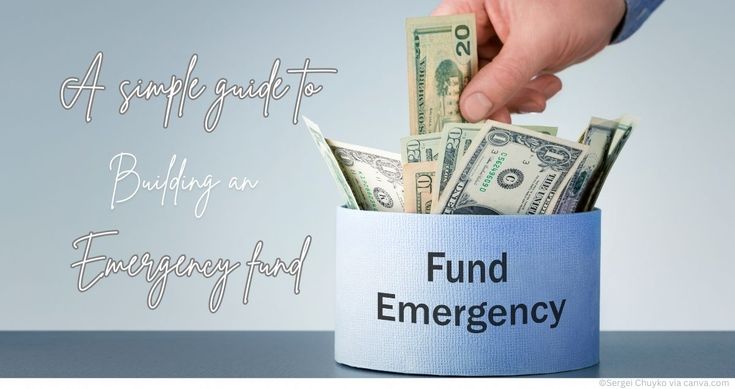What if your phone suddenly dies right before an important call, or you’re hit with a surprise medical bill after a minor accident, or your job takes an unexpected hit and your paycheck stops flowing. For most young adults, these “life happens” moments can instantly turn into major money worries. Without a plan, you might find yourself scrambling, dipping into savings you had for something else, or even worse, piling on high-interest debt. It’s a stressful cycle, and we want to help you break free from it. That’s where an emergency fund comes in – it’s your personal financial “shield” against life’s unpredictable moments.
At MintedMindz, we’re all about making your money work for you, not against you. And this guide will simplify exactly how to built an emergency fund, making it achievable for young adults like you, even on a tight budget. Ready to build your ultimate financial safety net?

Why This Fund is a Game-Changer (It’s More Than Just Emergencies)
It’s easy to assume that emergencies won’t happen to you — until they do. You might be thinking, “I barely have enough for my daily expenses, how can I save for an ’emergency’?” But trust us, an emergency fund isn’t just a nice-to-have; it’s a financial superpower. Its main job is to prevent you from falling into high-interest debt. Imagine your laptop dying just before a big project, or a sudden trip to the doctor. Without an emergency fund, a credit card might seem like your only option, leading to cycles of frustrating debt you can’t easily escape.
Beyond dodging debt, an emergency fund gives you incredible peace of mind. Knowing you have a financial cushion reduces anxiety and stress, letting you focus on your studies, work, or building that online business without the constant worry of “what if?” Most importantly, it creates opportunity. Once you have this financial safety net. You’re free to confidently explore other financial goals like investing in stocks or even diving into cryptocurrency. You can chase your dreams knowing you have a solid backup plan if things don’t go exactly as you hoped. So, it’s a foundational step towards true financial freedom.
Your Emergency Fund Target: How Much Do You Really Need?
So, the big question is How much emergency funds do you actually need? The “gold standard” you often hear about is having 3 to 6 months of your essential living expenses saved. What counts as “essential”? Think rent, utilities, basic groceries, transport, and any minimum loan payments. You can even check back on the “Needs” section of our “Budgeting Made Easy” guide to calculate this!

Now, for many young adults 3-6 months might sound like a massive mountain to climb. And that’s totally okay! At MintedMindz, we believe in realistic goals. For starters, aim for something more achievable, like $60,000, or perhaps one month’s worth of essential expenses. The goal here is progress, not immediate perfection. Think about your personal situation: How stable is your job? Do you have family support? What’s your health like? These factors can help you decide if you need to aim for the higher or lower end of that 3-6 month spectrum. Every little bit counts, and starting small is better than not starting at all.
How to Build Your Emergency Fund (Even on a Tight Budget!)
So how do you actually start saving? Here’s a simple plan that works — no matter what your income is. First, figure out your specific emergency fund goal based on your essential monthly expenses. Having a clear number makes your goal feel real and achievable. This is probably the most powerful step. Set up a recurring, automatic transfer from your checking account to a separate savings account right after you get paid. Even if it’s a small amount – say $1000 or $2000 every month. It adds up surprisingly fast because you never “see” the money to spend it. This is the ultimate “pay yourself first” strategy.
 To speed things up, look for temporary ways to boost your savings. This could mean temporarily trimming down your “Wants” from your budget, selling unused items around your home (old electronics, clothes you don’t wear), or dedicating any extra earnings from a side hustle entirely to your fund. Even small windfalls like birthday money or gifts can go straight into your emergency savings.
To speed things up, look for temporary ways to boost your savings. This could mean temporarily trimming down your “Wants” from your budget, selling unused items around your home (old electronics, clothes you don’t wear), or dedicating any extra earnings from a side hustle entirely to your fund. Even small windfalls like birthday money or gifts can go straight into your emergency savings.
You also have to track your progress. Seeing your fund grow is incredibly motivating. Use a simple spreadsheet, a free budgeting app, or even just a note on your phone to track your progress towards your goal. Visualizing your growth keeps you going and reminds you of the financial safety net you’re building.
Where to Keep Your Emergency Fund
Once you’ve decided on your target and started saving, the next big question is, where to keep your emergency fund? so it’s safe but also available when you need it. The ideal place is a separate, easily accessible, high-yield savings account. Look for banks that offer a slightly higher interest rate on savings. This means your money earns a little extra while it sits there, working for you. Crucially, it needs to be liquid (easy to get to) and safe, not locked away or exposed to risk.
You should definitely avoid keeping your emergency fund in:
-
Your regular checking account:
It’s far too easy to accidentally spend from here. You want this money out of sight, out of mind for daily expenses.
-
Investment accounts (stocks, crypto, etc.):
While exciting, these are too volatile for money you might need right now. An emergency fund needs to be stable and predictable. You can’t risk it losing value when you might need it most.
-
Cash at home:
It’s not safe from theft or accidents, it doesn’t grow, and it’s not insured.
The key principle is simple that your emergency fund needs to be readily available only for genuine emergencies, not for daily temptations or impulsive spending.
When (And Only When) to Use Your Emergency Fund
It’s crucial to understand that your emergency fund is like a superhero: it only comes out for serious crises. So, when is it okay to use it? These include unexpected job loss, a sudden medical emergency for you or someone dependent on you, essential car repairs that stop you from getting to work, or critical home repairs that make your living space unsafe. These are situations that genuinely impact your ability to live or earn.
It is not for that new gaming console, a vacation, holiday gifts, or impulsive shopping. These are “wants” that should come from your regular budget or specific savings goals. Dipping into your financial safety net for these things defeats its purpose. You can manage all these things with the help of any app and if you ask for my suggestion, i’ll suggest you YNAB but there’s a lot more in market you can easily find.
Build Your Shield Today!
Building an emergency fund is more than just having a stash of cash; it’s a foundational step towards cultivating a true Minted Mind. It gives you unparalleled peace of mind and confidence, knowing you’re ready for almost anything life throws your way. It’s also a powerful debt prevention tool, keeping you out of high-interest cycles when facing unexpected costs.
Most importantly, securing your emergency fund unlocks the freedom to grow. Once you have this solid buffer, you can confidently explore other exciting financial avenues like investing in the stock market, and dabbling in cryptocurrency, or even taking that leap to launch your own online business. You’ll know that even if things don’t go perfectly, you have a financial safety net to fall back on. Now if you are ready to take control on your financial destiny and built your first shield then i’m gonna give you 3 step to start:
- Calculate Your Target: Figure out how much you truly need for your emergency fund.
- Set Up Automation: Today, set up an automatic transfer from your checking to your chosen savings account. Even a small amount is a start.
- Commit to Boosters: Pick one temporary way to find extra cash (e.g., selling something, dedicating side hustle income) and put it straight into your fund.
And from now your challenge is to save money for an emergency fund. And make yourself financially strong. Lets take a first step to be strong in all ups and downs. Start prioritizing yourself!



